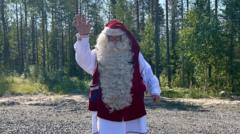Lapland is experiencing a scorching heatwave, with temperatures soaring as high as 31.7°C (89°F), prompting Santa Claus to adapt to this unprecedented weather. As his elves prepare for next Christmas, Santa reminds them and the reindeer to stay hydrated amidst these unusual conditions. "I'm only going out for a swim in the lake after 18:00," he shares, noting that his typical red, fur-trimmed outfit is hard to bear in such heat.
Rovaniemi, Santa's workshop hometown located above the Arctic Circle, has seen a continuous heatwave for 15 days and counting, breaking previous records set in 1972. The phenomenon is raising alarm among scientists, who attribute the unusual warmth in part to climate change. The Finnish Meteorological Institute's meteorologist Jaakko Savela explains that what could have been minor heat events are now significant due to a warming climate.
Multiple weather stations across Lapland have confirmed record-breaking temperatures exceeding seasonal norms, with the current heatwave believed to be influenced by broader, human-caused climate changes. Prof. Jeff Weller of the University of the Arctic highlights how accelerated climate shifts lead to more frequent extreme weather conditions, with implications for local wildlife, including reindeer, which are fleeing to roads for relief from bothersome mosquitoes.
Tourists visiting Lapland this summer are also taken aback by the uncharacteristic warmth. Many, like Silvia from Prague, arrive expecting a cooler climate only to find themselves unprepared for the heat. "I can barely even step outside the shade," shares Adita from London, reflecting the bewilderment of visitors and locals alike.
As climate trends suggest longer and more intense heatwaves in the Arctic, concerns mount about the future of Lapland's winter tourism. Elina, an elf at Santa's post office, expresses her anxiety over whether heatwaves could become the new normal.
For Santa, the challenges are a daily reality, as he can only venture out during cooler evening hours to avoid heat-related illness. He commented, “Of course a hot summer can be very nice for some, but I prefer cold and snow. Winter is better.” As Rovaniemi grapples with these changes, it signals a growing need to adapt to a future potentially devoid of the frosty winters that have defined this iconic region.
Rovaniemi, Santa's workshop hometown located above the Arctic Circle, has seen a continuous heatwave for 15 days and counting, breaking previous records set in 1972. The phenomenon is raising alarm among scientists, who attribute the unusual warmth in part to climate change. The Finnish Meteorological Institute's meteorologist Jaakko Savela explains that what could have been minor heat events are now significant due to a warming climate.
Multiple weather stations across Lapland have confirmed record-breaking temperatures exceeding seasonal norms, with the current heatwave believed to be influenced by broader, human-caused climate changes. Prof. Jeff Weller of the University of the Arctic highlights how accelerated climate shifts lead to more frequent extreme weather conditions, with implications for local wildlife, including reindeer, which are fleeing to roads for relief from bothersome mosquitoes.
Tourists visiting Lapland this summer are also taken aback by the uncharacteristic warmth. Many, like Silvia from Prague, arrive expecting a cooler climate only to find themselves unprepared for the heat. "I can barely even step outside the shade," shares Adita from London, reflecting the bewilderment of visitors and locals alike.
As climate trends suggest longer and more intense heatwaves in the Arctic, concerns mount about the future of Lapland's winter tourism. Elina, an elf at Santa's post office, expresses her anxiety over whether heatwaves could become the new normal.
For Santa, the challenges are a daily reality, as he can only venture out during cooler evening hours to avoid heat-related illness. He commented, “Of course a hot summer can be very nice for some, but I prefer cold and snow. Winter is better.” As Rovaniemi grapples with these changes, it signals a growing need to adapt to a future potentially devoid of the frosty winters that have defined this iconic region.


















